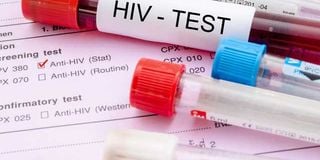Adolescent girls at greater HIV risk despite improvements

Adolescent Girls at Greater HIV Risk Despite Improvements
What you need to know:
- The new report shows that Kenya recorded a 26 percent progress in the reduction of adolescent deaths, higher than the global figure of nine percent.
- Kenya also recorded an increase in the number of adolescents aged between 15 and 19 getting antiretroviral therapy from 89 percent in 2021 to 96 per cent in 2023.
Kenya has made progress in reducing AIDS-related deaths among adolescents aged between 15 and 19 years old, according to the 2024 Global Alliance Progress Report on ending AIDS in children by 2030. The country ranked among the best-performing countries alongside Angola, Cameroon, Côte d’Ivoire, the Democratic Republic of Congo, Mozambique, Nigeria, South Africa, Tanzania, Uganda, Zambia and Zimbabwe Countries between 2021 and 2023.
The new report shows that Kenya recorded a 26 percent progress in the reduction of adolescent deaths, higher than the global figure of nine percent. Kenya also recorded an increase in the number of adolescents aged between 15 and 19 getting antiretroviral therapy from 89 percent in 2021 to 96 per cent in 2023.
Further, it recorded a 34 percent substantial decline in new HIV infections among adolescents during the same period. However, despite the decline, the report notes that 85 per cent of new HIV infections among older adolescents aged between 15 and 19 were recorded among adolescent girls, and 15 per cent being recorded among adolescent boys. Many of these infections, the data revealed, were acquired through sexual transmission.
“The global AIDS targets aim to reduce to less than 50,000 by 2025 the number of new HIV infections among adolescent girls and young women (15–24 years old), a priority population for HIV prevention generally and specifically for preventing vertical HIV transmission. In 2023, 210, 000 adolescent girls and young women acquired HIV globally, substantially exceeding the global target.” said the report. As a key measure in preventing vertical HIV transmission, the report recommended biomedical HIV prevention interventions for pregnant and breastfeeding women.
“In rural Kenya, a randomized controlled trial found that providing HIV self-tests to coupled, older adolescent women (15–19 years old) and counselling these women on how to avoid negative reactions from partners significantly increased self-reports that partners had been tested and that couples had been tested together. Available evidence highlights the importance of expanding HIV self-testing initiatives to strengthen HIV prevention among adolescent girls, including giving priority to younger individuals and couples while taking steps to minimize the risk of intimate partner violence,” adds the report.
“Giving priority to pregnant and breastfeeding women for biomedical HIV prevention interventions can also enhance the health and well-being of women and prevent vertical HIV transmission. In rural Kenya and Uganda, a dynamic client-centred programme that offered a choice of prevention methods (such as PrEP versus post-exposure prophylaxis), service location (clinic versus out of the facility) and testing approach (self-testing versus provider-administered) increased the coverage of biomedical HIV prevention in prenatal and postnatal settings by 40 percent and increased coverage during the months when women were at risk of acquiring HIV by 38 per cent.”
Data released early in 2023 by the National Syndemic Diseases Control Council showed that 13 counties in the country cut new HIV infections by half and that new infections at the national level also reduced significantly from 101,448 in 2013 to 22154 in 2022. The Council attributed this to the expansion of access to antiretroviral therapy medicine, which has seen about 1.2 million Kenyans access the treatment since 2013. In the report, Mombasa, Taita Taveta, Kilifi and Lamu Counties cut new HIV infections by half between 2021 and 2022. Other counties including Siaya, Kisumu, Tana River, Kwale, Homa Bay, Nairobi, Kisii, Nyamira and Migori cut new infections by between 44 and 49 percent.





